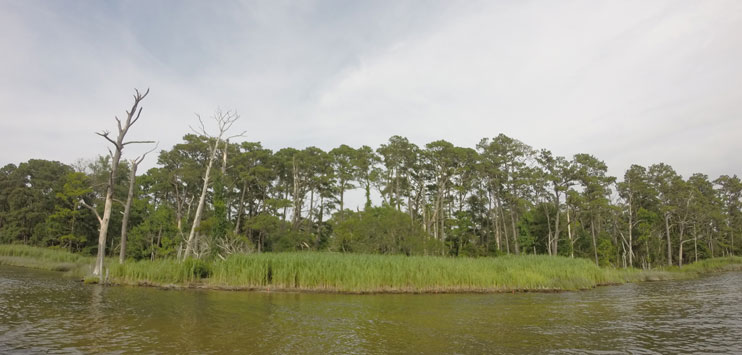Posted Sept. 1, 2015
Seth Theuerkauf is a 2015 North Carolina Sea Grant/N.C. Coastal Reserve and National Estuarine Research Reserve Program fellow. He is a doctoral candidate in biological oceanography at North Carolina State University’s Center for Marine Sciences and Technology.
“There’s a war being waged in the wetlands,” begins a 2004 Coastwatch article. The enemy is an aggressive line of the common reed, Phragmites australis, with European origins. It is practically identical to a native strain that has existed in North America’s wetland plant communities for more than 3,000 years.
The major difference between the two is the nonnative plant’s aggressive proliferation. Phragmites can spread at rates of up to 15 feet per year, choking out native marsh plants. North Carolina, like many other states in the United States, has been witness to the rapid expansion of this marsh grass.

The Phragmites australis marsh in Kitty Hawk Woods Reserve is one of my study sites. Photo by Seth Theuerkauf
Across its invasive range, numerous negative effects of Phragmites on marsh ecosystems have been reported, including reductions in plant diversity and in habitat used by threatened and endangered birds. However, there is evidence that Phragmites may help reduce shoreline erosion and bury carbon at rates faster than native marsh grasses.
Furthermore, Phragmites management generally entails the eradication of existing stands within marshes using fire or herbicides, methods that often require control techniques to be employed for many years after. These efforts are costly, labor intensive and potentially dangerous.
Within the marshes of the state’s Reserve network, Phragmites is present in varying amounts — from large stands over an acre in size to smaller patches that are growing alongside other native marsh plants, such as big cordgrass, Spartina cynosuroides.
My research, funded by North Carolina Sea Grant and the N.C. Coastal Reserve and National Estuarine Research Reserve Program, focuses on understanding how Phragmites affects the ability of marshes to provide valuable services, such as plant diversity, erosion control and carbon sequestration.
This applied research will provide the Reserve with specific data that can be used to identify the main areas for Phragmites management.
I have been hard at work this field season in the marshes of the Currituck Banks and Kitty Hawk Woods reserves in the northeastern portion of our state where Phragmites is prevalent. I have a diverse research team helping out.
The Reserve is represented by Brandon Puckett, research coordinator; Scott Crocker, northern sites manager; and Samantha Godwin, undergraduate intern.
They are joined by graduate student Katelyn Theuerkauf — also my wife — from North Carolina State University’s Center for Marine Sciences and Technology, and Athena Edwards, West Carteret High School student and Sea Wolf summer research aide.
My brother Ethan Theuerkauf, a doctoral candidate from the University of North Carolina at Chapel Hill’s Institute of Marine Sciences, also is part of the team.

From left to right, Katelyn Theuerkauf, Samantha Godwin and Brandon Puckett deploy stakes to monitor marsh erosion at Currituck Banks Reserve. Photo by Seth Theuerkauf
On our first research trip into the marshes of Currituck Banks and Kitty Hawk Woods reserves, we set stakes that will enable us to monitor erosion at sites where Phragmites only, native marsh plants only, and mixed Phragmites and native marsh plants were present.
Our goal is to return to these locations in subsequent years to identify if there are any differences in shoreline erosion, depending on the marsh plants that are present. Observational evidence suggests that the dense root structure of Phragmites, a characteristic often associated with its ability to rapidly proliferate, may enhance its ability to prevent shoreline erosion.
In early September, we will be returning to the marshes to conduct vegetation transects to assess plant diversity. During these transects, we will count and identify plants at fixed distances along a specified path.
Given the wealth of plant diversity present in the marshes at these sites, the data collected through this portion of the project should prove interesting — and our research trips will likely yield some great photos of some of the amazing marsh plants you can observe at these locations.
Follow me on Twitter at @sjtheuer, or hit the hiking trails at the Reserve sites to see for yourself! And keep an eye out for project updates and results in a future issue of Coastwatch.